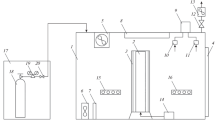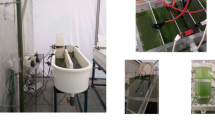Abstract
A flue gas originating from a municipal waste incinerator was used as a source of CO2 for the cultivation of the microalga Chlorella vulgaris, in order to decrease the biomass production costs and to bioremediate CO2 simultaneously. The utilization of the flue gas containing 10–13% (v/v) CO2 and 8–10% (v/v) O2 for the photobioreactor agitation and CO2 supply was proven to be convenient. The growth rate of algal cultures on the flue gas was even higher when compared with the control culture supplied by a mixture of pure CO2 and air (11% (v/v) CO2). Correspondingly, the CO2 fixation rate was also higher when using the flue gas (4.4 g CO2 l−1 24 h−1) than using the control gas (3.0 g CO2 l−1 24 h−1). The toxicological analysis of the biomass produced using untreated flue gas showed only a slight excess of mercury while all the other compounds (other heavy metals, polycyclic aromatic hydrocarbons, polychlorinated dibenzodioxins and dibenzofurans, and polychlorinated biphenyls) were below the limits required by the European Union foodstuff legislation. Fortunately, extending the flue gas treatment prior to the cultivation unit by a simple granulated activated carbon column led to an efficient absorption of gaseous mercury and to the algal biomass composition compliant with all the foodstuff legislation requirements.





Similar content being viewed by others
References
Benemann JR (1993) Utilization of carbon dioxide from fossil fuel-burning power plants with biological systems. Energy Convers Mgmt 34:999–1004
Benemann JR (1997) CO2 mitigation with microalgae systems. Energy Convers Mgmt 38:S475–S479
Brown LM (1996) Uptake of carbon dioxide from flue gas by microalgae. Energy Convers Mgmt 37:1363–1367
Brown LM, Zeiler KG (1993) Aquatic biomass and carbon dioxide trapping. Energy Convers Mgmt 34:1005–1013
Chae SR, Hwang EJ, Shin HS (2006) Single cell protein production of Euglena gracilis and carbon dioxide fixation in an innovative photo-bioreactor. Bioresource Technol 97:322–329
Del Campo JA, Garcia-Gonzalez M, Guerrero MG (2007) Outdoor cultivation of microalgae for carotenoid production: current state and perspectives. Appl Microbiol Biotechnol 74:1163–1174
Doucha J (1979) Continuous cultures of algae. In: Marvan P, Přibil S, Lhotský O (eds) Algal assays and monitoring eutrophication, 1st edn. Schweizerbart’sche Verlagbuchhandlung, Stuttgart, pp 181–191
Doucha J, Livansky K (2006) Productivity, CO2/O2 exchange and hydraulics in outdoor open high density microalgal (Chlorella sp.) photobioreactors operated in a Middle and Southern European climate. J Appl Phycol 18:811–826
Doucha J, Straka F, Livansky K (2005) Utilization of flue gas for cultivation of microalgae (Chlorella sp.) in an outdoor open thin-layer photobioreactor. J Appl Phycol 17:403–412
Douskova I, Doucha J, Machat J, Novak P, Umysova D, Vitova M, Zachleder V (2008) Microalgae as a means for converting flue gas CO2 into biomass with high content of starch. Proceedings of the International Conference: Bioenergy: Challenges and Opportunities, 6th/9th April 2008, Guimaraes, Portugal
EC (4 December 2000) Directive No 2000/76/EC of the European Parliament and of the Council of 4 December 2000 on the incineration of waste
EC (19 December 2006) Commission Regulation No 1881/2006 setting maximum levels for certain contaminants in foodstuffs
EN 1948:1996 (1996) Stationary source emissions—determination of mass concentration of PCDDs/PCDFs and dioxin-like PCBs
Foyer CH, Noctor G (2000) Oxygen processing in photosynthesis: regulation and signalling. New Phytol 146:359–388
Galloway RA, Gauch HG, Soeder CJ (1964) Effects of inhibitory levels of CO2 on Chlorella. Plant Physiol 39:R8
Hu Q, Kurano N, Kawachi M, Iwasaki I, Miyachi S (1998) Ultrahigh-cell-density culture of a marine green alga Chlorococcum littorale in a flat-plate photobioreactor. Appl Microbiol Biotechnol 49:655–662
Kadam KL (1997) Plant flue gas as a source of CO2 for microalgae cultivation. Economic impact of different process options. Energy Convers Mgmt 38:S505–S510
Kadam KL (2002) Environmental implications of power generation via coal-microalgae cofiring. Energy 27:905–922
Kurano N, Ikemoto H, Miyashita H, Hasegawa T, Hata H, Miyachi S (1995) Fixation and utilization of carbon dioxide by microalgal photosynthesis. Energy Convers Mgmt 36:689–692
Maeda K, Owada M, Kimura N, Omata K, Karube I (1995) CO2 fixation from the flue gas on coal-fired thermal power plant by microalgae. Energy Convers Mgmt 36:717–720
Matsumoto H, Hamasaki A, Sioji N, Ikuta Y (1997) Influence of CO2, SO2 and NO in flue gas on microalgae productivity. J Chem Eng Japan 30:620–624
Murakami M, Ikenouchi M (1997) The biological CO2 fixation and utilization project by RITE. 2. Screening and breeding of microalgae with high capability in fixing CO2. Energy Convers Mgmt 38:S493–S497
Negoro M, Hamasaki A, Ikuta Y, Makita T, Hirayama K, Suzuki S (1993) Carbon dioxide fixation by microalgae photosynthesis using actual flue gas discharged from a boiler. Appl Biochem Biotechnol 39:643–653
Radwan SS (1991) Sources of C-20-polyunsaturated fatty acids for biotechnological use. Appl Microbiol Biotechnol 35:421–430
Sasaki K, Watanabe M, Tanaka T (2002) Biosynthesis, biotechnological production and applications of 5-aminolevulinic acid. Appl Microbiol Biotechnol 58:23–29
Spolaore P, Joannis-Cassan C, Duran E, Isambert A (2006) Commercial applications of microalgae. J Biosc Bioeng 101:87–96
Vyhlaska 305/2004 Sb.—Decree of the Government of the Czech Republic No. 305/2004 Code establishing types of contaminants and their maximum levels in foodstuffs (in Czech)
Yoshihara KI, Nagase H, Eguchi K, Hirata K, Miyamoto K (1996) Biological elimination of nitric oxide and carbon dioxide from flue gas by marine microalga NOA-113 cultivated in a long tubular photobioreactor. J Ferm Bioeng 82:351–354
Acknowledgments
This work was supported by the project EUREKA of the Ministry of Education, Youth and Sports of the Czech Republic (No. OE221) and by the Institutional Research Concept No. AV0Z5020510. The authors gratefully acknowledge Ing. Frantisek Straka, PhD (Fuel Research Institute, Bechovice, Czech Republic) for providing the pure gas mixtures.
Author information
Authors and Affiliations
Corresponding author
Rights and permissions
About this article
Cite this article
Douskova, I., Doucha, J., Livansky, K. et al. Simultaneous flue gas bioremediation and reduction of microalgal biomass production costs. Appl Microbiol Biotechnol 82, 179–185 (2009). https://doi.org/10.1007/s00253-008-1811-9
Received:
Revised:
Accepted:
Published:
Issue Date:
DOI: https://doi.org/10.1007/s00253-008-1811-9




